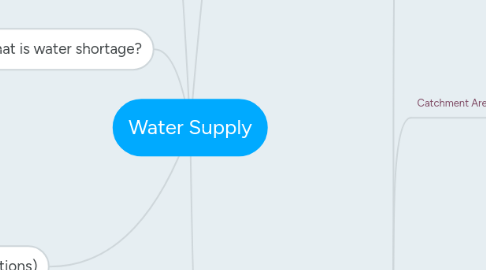
1. What is water shortage?
1.1. Scarcity
1.1.1. When fresh water availability is lower than 1000 cubic metres
1.2. Vulnerability
1.2.1. When fresh water availability is between 1701 and 2500 cubic metres.
1.3. stress
1.3.1. When fresh water availability is between 1001 and 1700 cubic metre.
1.4. security
1.4.1. There is an adequate and sustainable fresh water for human consumption and use. This happens when fresh water availability is more than 2500 cubic metres
1.5. Definition
1.5.1. Occurs when the level of water shortage exceeds the water supply available.
2. Impact of water shortage
2.1. Will not be enough water for the people to drink
2.2. Will not have enough water to wash clothes
2.3. Will not have enough water to wash and cook food
3. Distribution of water (locations)
3.1. Water footprint
3.1.1. How much water resources are used in the production of a product and in the consumption/use of a product
3.2. Locations facing water shortage
4. Why water shortage?
4.1. Increasing Demand
4.1.1. Affluence
4.1.1.1. More money
4.1.1.1.1. Lifestyle
4.1.2. Population growth
4.1.2.1. More uses
4.1.2.1.1. Domestic
4.1.2.1.2. Economic
4.2. Decreasing Supply
4.2.1. Uneven distribution/ availibility of water
4.2.1.1. Limited supply of water
4.2.1.1.1. Naturally water is not available
4.2.2. Climate
4.2.2.1. Climate change
4.2.2.1.1. Droughts
4.2.2.1.2. Floods
4.2.3. Water polution
4.2.3.1. Agriculture
4.2.3.2. Industrial
4.2.3.2.1. Industrialization is beside the river
4.2.3.3. Public landfill
4.2.3.3.1. River flooded with litter
4.2.3.4. Natural
4.2.3.4.1. Soil erosion
4.2.3.5. Domestic
4.2.3.5.1. Sewage
4.2.3.5.2. Car
4.2.3.6. Impact
4.2.3.6.1. Fishes/ marine animals die
5. Most important water
5.1. Imported H2O
5.1.1. Advantages
5.1.1.1. 2nd national tap
5.1.1.2. It is the main source of water
5.1.1.3. 40% of water from Johor
5.1.1.4. Majority of water comes from here=necessary to meet demad
5.1.2. Disadvantages
5.1.2.1. Contract will end in 2061
5.1.2.2. They might not want to renew the contract
5.1.2.3. Not enough supply
5.2. Catchment Area
5.2.1. Advantages
5.2.1.1. Rainfall is collected
5.2.1.2. Catchment areas
5.2.1.2.1. Canals
5.2.1.2.2. Drains
5.2.1.2.3. Resevoirs
5.2.1.3. High rainfall
5.2.1.4. Self-reliant
5.2.1.5. Need to provide as we do not need to pay for it
5.2.1.6. Natural sources= frree
5.2.2. Disadvantages
5.2.2.1. When there is little rainfall, cannot collect
5.2.2.2. Demand
5.2.2.3. Land constraint
5.2.2.4. Dependant on climate
5.3. Dealinated H2O
5.3.1. Advantages
5.3.1.1. Technology based water resources
5.3.1.2. Removing salt from seawater
5.3.1.3. Other unlimited supply
5.3.1.4. Ensures high quality drinkable water
5.3.1.5. 25% of water demand will be met (?)
5.3.1.6. SG is surrounded by seawater
5.3.1.7. Self-reliant
5.3.2. Disadvantages
5.3.2.1. Costly
5.3.2.1.1. Needs technology and equipment
5.3.2.2. Pollution
5.3.2.2.1. Chemicals and salt
5.3.2.3. Land constraint
5.3.2.4. Impacts on environment
5.3.2.4.1. Detroys marine life
5.3.2.4.2. imbalance in salt and water
5.4. NEWater
5.4.1. Advantages
5.4.1.1. 3rd national tap
5.4.1.2. Used water that is purified
5.4.1.3. Ultra clean
5.4.1.4. 1st newater plant opened in 2003
5.4.1.5. 30% current water needed
5.4.1.6. Wants to meet 50% in future
5.4.1.7. Self-reliant
5.4.1.8. Environmentally friendly
5.4.1.9. Cheaper than desalinated water
5.4.1.10. Long term solution
5.4.2. Disadvantages
5.4.2.1. Energy is used
5.4.2.2. Conflict
5.4.2.2.1. Drinking reused water
5.4.2.3. Expensive
5.4.2.4. Land constraint

